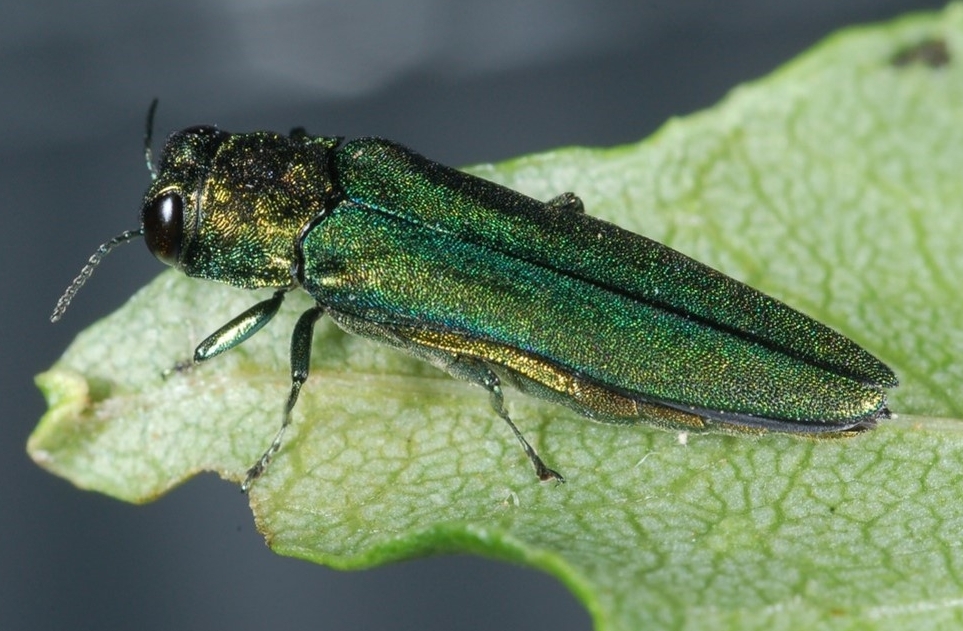Emerald Ash Borer
Why is EAB a problem?
While adult beetles only feed on foliage, causing minimal damage, the larvae burrow beneath the bark and stop the flow of water and nutrients, leading to the tree's death.
In Calgary, we have an estimated total of 250,000 ash trees on public and private land. This means EAB poses a threat to our urban canopy.
What The City is doing
While EAB has not yet been found in Calgary, we are focused on early detection which is critical to helping slow the spread of EAB and prolong the life of our ash trees.
Each spring we set up traps throughout Calgary to monitor for EAB. The green prism traps, made of corrugated plastic, are placed in ash trees across the city from late May to early September. The traps are coated with sticky glue on the outside and baited with pheromone lures to attract insects.
If you find one of the traps while we’re monitoring in the spring and summer, please:
- Don't touch the outside of the trap, as it is coated with sticky glue that may cause skin irritation.
- Do not touch the lures inside the trap; they will be placed back into the tree for the remainder of the monitoring season.
- Contact 311 so we can try to locate and replace the trap.
In addition to using the traps for EAB detection, we are:
- Conducting sampling on ash branches (peeling back the bark to look for signs of EAB like s-shaped galleries).
- Training staff to detect the signs and symptoms of EAB.
- Having staff and volunteers conduct visual surveys of ash trees for any signs of EAB.
- Offering public education during our seasonal pests and pruning workshops and at info booths set up at various city parks, as well as through social media posts.
We also collaborate with surrounding municipalities and provincial and federal partners to monitor the spread of EAB across Canada and the United States.
What you can do
EAB adults can fly up to 10km per year but can spread much faster with unintentional human help. The transport of infested ash products, such as firewood, is the primary method of human-assisted spread. The number one thing to stop the spread of EAB is to ‘Burn It Where You Buy It’ and not transport firewood from place to place.
While we can monitor public trees, there are an estimated 180,000 private ash trees in the city. Calgarians can help by looking out for signs and symptoms of EAB in their own ash trees.
How to identify an ash tree
The easiest way to spot an ash tree is by looking at the leaves. Ash trees have compound leaves, made up of a bud with five or more similarly shaped leaflets.
Signs and symptoms of emerald ash borer
Signs of infestation on a tree include:
- D-shaped exit holes in the tree bark.
- Winding or S-shaped markings under the tree bark (left from larval feeding).
- Canopy thinning or branch dieback, especially in the upper canopy.
- Woodpecker damage, such as holes, bark flaking/peeled bark or the presence of woodpeckers on ash trees (note: this is most noticeable in winter when there are no leaves on the trees).
S-shaped galleries and D-shaped holes are important indicators of EAB since no native pests leave these signs in ash. Woodpecker feeding is also strongly associated with EAB. Rapid decline (decline occurs in approximately 1-3 years) or branch dieback are red flags and should be looked at more closely.
Other things to look out for include bark splitting or cracking and epicormic shoots (also known as water sprouts or suckers) growing from the trunk of the tree. However, these are often general signs of stress and can be common, so do not necessarily indicate EAB.
Adult EAB beetles are metallic green, about 8.5 to 14mm long, and 3 mm wide.
Examples of emerald ash borer damage (click photo to expand):
Photo credits: Troy Kimoto, Canadian Food Inspection Agency, Bugwood.org; David Cappaert, Bugwood.org; Daniel Herms, The Ohio State University, Bugwood.org; Jim Tresouthick, Village of Homewood, Bugwood.org.
Native pests or EAB?
Western ash bark beetle (WABB) is a common pest of ash trees in Calgary. WABB infested trees may also be associated with woodpeckers and may show similar symptoms to EAB. For example:
- Exit holes – WABB exit holes are small and round rather than D-shaped.
- Galleries – WABB galleries are small and perpendicular rather than S-shaped.
WABB only attacks weakened or unhealthy trees.
Examples of western ash bark beetle damage (click photo to expand):
Photo credits: Whitney Cranshaw, Colorado State University, Bugwood.org.
Additional resources
Download our fact sheet on EAB.
Download the Canadian Food Inspection Agency’s EAB pest card
Visit the Canadian Food Inspection Agency’s EAB page for additional information and resources.


